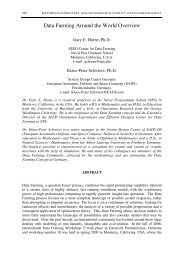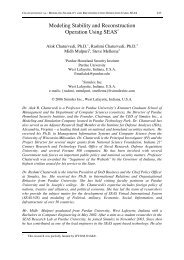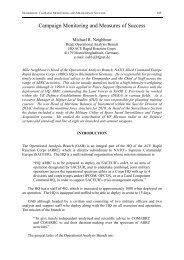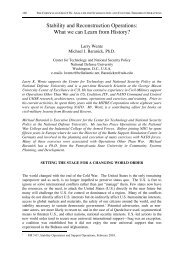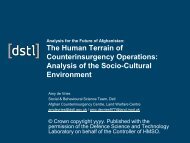The British Army's Effectiveness in the Irish ... - Cornwallis Group
The British Army's Effectiveness in the Irish ... - Cornwallis Group
The British Army's Effectiveness in the Irish ... - Cornwallis Group
Create successful ePaper yourself
Turn your PDF publications into a flip-book with our unique Google optimized e-Paper software.
94 THE CORNWALLIS GROUP XIV: ANALYSIS OF SOCIETAL CONFLICT AND COUNTER-INSURGENCY<br />
autonomy. Even more remarkably, after <strong>the</strong> truce it was determ<strong>in</strong>ed by Brita<strong>in</strong>’s Chief Justice<br />
<strong>the</strong> Master of <strong>The</strong> Rolls that <strong>the</strong> imposition of Martial Law was itself illegal.<br />
IRA TACTICS<br />
<strong>The</strong> IRA’s approach was described <strong>in</strong> <strong>the</strong>ir own journal An t-Oglach:<br />
‘We will strike <strong>in</strong> our own way, <strong>in</strong> our own time. If we cannot, by force of<br />
arms, drive <strong>the</strong> enemy out of our country at <strong>the</strong> present moment, we can help<br />
to make his position impossible and his military activities futile’.<br />
Exactly when and who formed this strategy is unclear, but it is likely to have begun <strong>in</strong> a<br />
distillery <strong>in</strong> North Wales <strong>in</strong> late 1916, which had been converted <strong>in</strong>to a temporary <strong>in</strong>ternment<br />
camp for those who participated <strong>in</strong> <strong>the</strong> Easter Rebellion. 15 Michael Coll<strong>in</strong>s and Richard<br />
Mulcahy (IRA Chief of Staff) were certa<strong>in</strong>ly <strong>in</strong>strumental, but o<strong>the</strong>rs such as Cathal Brugha,<br />
Bulmer Hobson and Eo<strong>in</strong> MacNeill had also concluded that Brita<strong>in</strong> was far too strong for<br />
direct conflict. 16 By 1918, <strong>the</strong> Volunteer movement had spread across <strong>the</strong> country, although it<br />
still used <strong>British</strong> military concepts of brigades, battalions and companies. <strong>The</strong> problem was<br />
however that <strong>the</strong>y lacked sufficient weapons and ammunition to provide a credible military<br />
response. Thus <strong>the</strong> first steps were <strong>the</strong> raids on unguarded RIC barracks, which conta<strong>in</strong>ed<br />
weapons. <strong>The</strong>se raids gave volunteers <strong>the</strong>ir first taste of action and would embolden later<br />
attacks on manned police bases, with <strong>the</strong> use of explosives <strong>in</strong> improvised m<strong>in</strong>es. IRA units<br />
whose officers were Great War veterans, ironically from <strong>the</strong> <strong>British</strong> Armed Forces, would<br />
<strong>in</strong>evitably develop <strong>the</strong> basic military skills more quickly than o<strong>the</strong>rs. Similarly, those which<br />
already possessed weapons and had not been caught up <strong>in</strong> Easter 1916, were and would<br />
rema<strong>in</strong> <strong>the</strong> most active throughout <strong>the</strong> war.<br />
From attack<strong>in</strong>g manned police stations, <strong>the</strong> obvious next step was attack<strong>in</strong>g police<br />
directly. Despite <strong>the</strong> fact that <strong>the</strong> police were all <strong>Irish</strong>men, <strong>the</strong>y were derided as <strong>in</strong>struments<br />
of <strong>British</strong> occupation, a campaign that had begun <strong>in</strong> 1918. Follow<strong>in</strong>g Soloheadbeg, <strong>the</strong><br />
target<strong>in</strong>g of <strong>the</strong> police accelerated, although it could take many forms. S<strong>in</strong>n Fe<strong>in</strong> began a<br />
boycott of <strong>the</strong> police and <strong>the</strong>ir families <strong>in</strong> April 1919. <strong>The</strong> need to deny <strong>in</strong>formation to <strong>the</strong><br />
authorities meant that <strong>the</strong> political crimes officers, from G Branch <strong>in</strong> <strong>the</strong> DMP and <strong>the</strong><br />
Special Crimes sergeants <strong>in</strong> <strong>the</strong> RIC, were high-value targets. In some notable cases,<br />
<strong>in</strong>dividuals already sympathised with <strong>the</strong> S<strong>in</strong>n Fe<strong>in</strong> aims and would turn a bl<strong>in</strong>d eye to IRA<br />
actions or <strong>in</strong> some cases pass <strong>in</strong>formation. Where this cooperation did not take place,<br />
assass<strong>in</strong>ation was a real possibility and between January 1919 and October 1920, over 100<br />
RIC men were killed. In parallel, <strong>the</strong> <strong>British</strong> were forced to withdraw from many areas where<br />
<strong>the</strong> police stations could not be protected, and <strong>the</strong> rema<strong>in</strong><strong>in</strong>g stations became larger and more<br />
fortified.<br />
Throughout 1919, <strong>the</strong> military campaign evolved but by <strong>the</strong> end of <strong>the</strong> year when <strong>British</strong><br />
army units became drawn <strong>in</strong>to <strong>the</strong> conflict, <strong>the</strong> IRA was forced to expand <strong>the</strong>ir actions.<br />
Attacks on government <strong>in</strong>stitutions followed <strong>the</strong> suppression of <strong>the</strong> Dail <strong>in</strong> September 1919.<br />
15 Lyn Ebenezer, Fron-Goch and <strong>the</strong> Birth of <strong>the</strong> IRA (Llanrwst: Gwasg Carreg Gwalch, 2006), 106-122.<br />
16 M L R Smith, Fight<strong>in</strong>g for Ireland? : <strong>The</strong> Military Strategy of <strong>the</strong> <strong>Irish</strong> Republican Movement (London:<br />
Routledge, 1997), 30-55.



